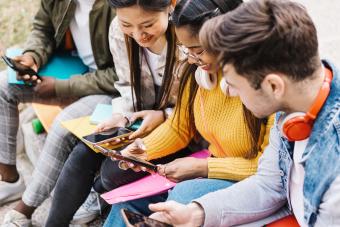
Most parents and educators agree on the importance of documenting children's learning as part of their learning process. There are many ways to show off your child's interests, thought process, and learning discoveries as part of documentation.
What Is Learning Documentation?
Although it sounds very formal, learning documentation is pretty simple. It's basically a way of telling the story and reason behind events, experiences, or development. Documentation is a tangible and visible display of a child's learning process that engages those who look at it. Effective documentation tells the whole story which is why it's easier for educators and kids to choose one topic and explore it fully before moving on to another topic. Learning documentation is a collaboration between parents, teachers, and students to understand an event or topic.
Why Is Documenting Children's Learning Important?
Documenting a child's learning process and achievements helps the child, teacher, and parents in important social, emotional, physical, and cognitive ways. Different types of documentation serve different purposes, but mostly they provide opportunities for further learning and development. Documentation is most often associated with preschool and kindergarten, but can be useful across all grade levels.
Documentation and Learning objectives
Learning objectives serve as guidelines for what is appropriate in terms of learning at each developmental age. Learning documentation relates to learning objectives because it:
- Provides written goals
- Provides a way to evaluate progress toward goals
- Shows strengths and deficits in learning and curriculum
How Documentation Benefits the Student
Kids benefit greatly from educational documentation both internally and externally because it:
- Shows their process of learning
- Allows kids the chance to self-reflect
- Makes the child's learning process feel important
- Focuses on the positives which can enhance self-esteem and confidence
- Provides relatable examples to look back on
How Documentation Benefits the Teacher
Learning documentation supports the teacher's ability to guide and mentor each child because it:
- Enhances and focuses communication with parents
- Guides lesson and activity planning
- Holds teachers accountable for providing appropriate learning opportunities
- Allows teachers the chance to self-reflect on their methods
- Helps teachers get to know each student better
How Documentation Benefits the Parents
Parents don't always get to see all the learning their children do, especially if their kids go to a public or private school, so documentation is helpful because it:
- Enhances and focuses communication with school
- Shows what their child is capable of
- Helps parents get to know their children better
- Provides talking points for parent-child conversations
Approaches to Documenting a Child's Learning
There are several approaches to learning documentation and your first step is choosing one to embody with your child at home or in your classroom. The approach you pick will determine the types of documentation you use.
Classical Documentation
This form of learning documentation is what most people are probably familiar with. Things like tests and learning assessments fall into this category where they were meant to account for changes and progress in child development. Classical documentation doesn't necessarily involve the child in the documentation process and doesn't show the process of learning.
Pedagogical Documentation
A pedagogical approach to documentation is all about understanding how learning takes place for each child and sharing that information with stakeholders in the child's life. Educators gather documents from test scores to classroom observations, study and analyse the whole body of data, then discuss with the child and parents their understanding of what all the documentation says about the child.
Holistic Approach to Documentation
The Alina Dan Holistic Approach to Documentation out of Australia seeks to document learning from multiple angles and places value on educators as "critical and unique." Through a complex group of documentation types, this approach intertwines the child's approaches to learning and the teacher's philosophy. Children and adults in the holistic view have equal value and rights in the educational process.
Reggio Emilia Inspired Documentation
The Reggio Emilia approach is a way to view and implement childhood education used in a small Italian village. Programs that are inspired by this approach use child-led learning that focuses on documenting the child's thoughts and thought-process, not grades and test scores. Some ways learning is documented with this approach include artistic and linguistic materials made by the student.
Examples of Documenting Children's Learning
The ways you can document a child's learning are only limited by your imagination. You can incorporate several types of documentation and approaches to fit the needs and desires of the child. Learning documentation examples can be seen in most educational settings.

These common school practices serve as great examples of learning documentation:
- Bulletin board displays that show a process like an idea web
- Children's writing samples
- A photo of the child engaged in learning captioned with a comment the child made about it
- Observation notes written by teachers
- Student journal
- PowerPoint presentation of a learning unit after it has been completed
- Individual portfolios showing progress in specific domains across time
Showing The Process of Learning
Learning documentation moves from the traditional educational focus of "before and after" to a modern focus on "the journey." The idea is that parents, teachers, and students work together to create and understand tangible representations of each child's unique learning process.







